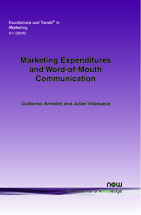Marketing Expenditures and Word-of-Mouth Communication: Complements or Substitutes?
By Guillermo Armelini, Marketing Department, ESE Business School, University los Andes, Chile, garmelini.ese@uandes.cl | Julian Villanueva, Marketing Department, IESE Business School, University of Navarra, Spain, JVillanueva@iese.edu
Abstract
In this monograph we examine the extent to which word-of-mouth communication (WOM) plays a complementary and/or substitute role with regard to advertising. A review of the existing literature reveals the main similarities and differences between these constructs. We also examine the conditions in which a social contagion process is most likely. Specifically, our literature review helps us answer the following questions: whether WOM complements the advertising effect, when and how WOM can be a substitute of the marketing effort, and which issues limit WOM's ability to inform and persuade consumers. Published empirical evidence suggests that in most cases WOM complements advertising; however, three marketing strategies — viral marketing, referral reward programs, and a firm's creation of exogenous WOM — might work without advertising. This monograph concludes with a list of unanswered questions of potential interest to both researchers and managers.
Marketing Expenditures and Word-of-Mouth Communication
Marketing Expenditures and Word-of-Mouth Communication reviews the existing literature on WOM and advertising to determine whether and how WOM provides a complement to or substitute of advertising spending within the firm's marketing strategy. The authors highlight the main similarities and differences between WOM and advertising. After describing the conditions in which a process of social contagion is more likely to occur, the complementary/substitutive relationship between WOM and advertising is analyzed. Marketing Expenditures and Word-of-Mouth Communication helps answer the following questions: whether WOM complements the advertising effect; when and how WOM can be a substitute of the marketing effort; which issues limit WOM's ability to inform and persuade consumers. Published empirical evidence suggests that in most cases WOM complements advertising. However, three marketing strategies – viral marketing, referral reward programs, and a firm's creation of exogenous WOM – might work without advertising. The authors conclude with a list of unanswered questions of potential interest to both researchers and managers
